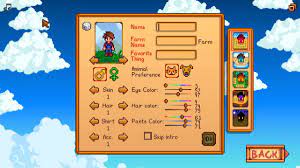Introduction to Stardew Valley
For this week’s Critical Play, I played Stardew Valley on my iPhone, a role-playing game created by Eric Barone. Despite its whimsical theming, this game is meant for the casual player ages 13+, interacting with some more mature themes and decision-making.
Gameplay & Analysis
From my experience playing the game, Stardew Valley takes a progressive stance towards gender norms. Despite selecting a female character, I still engaged activities traditionally associated with masculinity–including farming, mining, and fishing–and felt empowered to break gender stereotypes in the process. In addition, Stardew Valley further supports inclusivity through its relationship-building mechanism. As discussed in Play Like a Feminist, the game exists in this never-ending middle narrative space, creating a climax-less space for players to merely explore a variety of issues and make decisions including choosing a romantic partner. The game allows your character to pursue relationships with anyone in the valley, regardless of gender. Your character can flirt with and initiate relationships with both males and females and have your interest reciprocated without judgement or confusion.
However, despite the freedom of choice for your partner, throughout the game, it became increasingly apparent that the majority of characters conform to traditional heterosexual norms when pairing up with one another, as seen in the cut scenes and dialogue. Thus, where Stardew Valley falls short is in the representation of nontraditional relationships within the game. Furthermore, the game still restricts to a binary gender system in which players are forced to choose between two genders for their character and interact with gendered characters.

The creation of your character was also a potential fail for me. While I appreciated the customizability of your character, I found that frontloading all the work of setting up right to the beginning posed an obstacle to onboarding me into the game. I almost felt discouraged from playing upon seeing the screen above and seeing how many decisions I would have to make, especially since I felt stressed to make my character perfect from the start. Thus, I would prefer if the game integrated the customization of your character into the gameplay itself, such as having the player only make a couple of choices for their character at the start and then slowly having new options for changing eye color, hair color, and more come up as you move through the game (such as in a beauty salon where you can dye hair or choose contacts).
Concluding Thoughts
From a feminist perspective, Stardew Valley provides opportunities for players to subvert gender roles and explore a range of activities and relationships. However, it falls short in fully embracing intersectional feminism by pursuing a binary gender system and reinforcing traditional romantic expectations in the relationships of their supplemental characters. Thus, to further improve the game from a feminist standpoint, Stardew Valley could opt to incorporate a more nuanced gender system that includes non-binary options and break traditional romantic norms in the romantic pairings of their supplemental characters
By working to further integrate feminist perspectives into the game, Stardew Valley could expand its inclusivity and address the concerns of underrepresented communities, enhancing the gaming experience and contributing to a more inclusive and progressive gaming culture.
So my question for discussion is how can Stardew Valley navigate the range of gender identities in real life and reflect this in their game?




